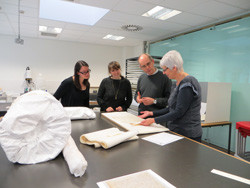Innovations in the study of parchment
The project 'Unlocking historical and molecular archives' (PALIMPSEST) used mass spectrometry of minute quantities of collagen to identify the correct species used and to learn about parchment quality and methods of production. The non-destructive sampling technique was developed in close collaboration with conservation departments. Using materials compatible with standard surface conservation treatments, the team was able to extract minute amounts of collagen from the residue produced as a result of cleaning. The collagen proved to be the key to identifying species used to make the parchment. The simple procedure requires no specialist training and puts the sampling in the hands of those comfortable with these materials (conservators and curators). Because the methodology is safe for old documents, the team had unprecedented access to libraries and archives. Over the course of the project, researchers analysed in excess of 1 000 documents spanning 3 continents covering a period of 1 400 years. In addition to animal identification, researchers were able to evaluate a specific type of damage that occurs in the collagen molecule. The damage is related to the quality and method of production of the parchment, or the time exposed to lime for dehairing. This discovery provided insight into changing manufacturing processes. The project resulted in an international network, with partners in Europe and the United States. The rich collections found in institutions in these countries have the potential to provide a more complete picture of parchment use throughout the Middle Ages. PALIMPSEST was successful on many fronts. It produced a wealth of data, as well as a non-destructive sampling technique with the potential for numerous applications. Not only does project work represent the beginning of a new stage in manuscript studies, it also introduced the concept of biomolecular codicology, opening the field to further analysis and interest from multidisciplinary perspectives.
Keywords
Parchment, molecular archives, mass spectrometry, collagen, non-destructive sampling



